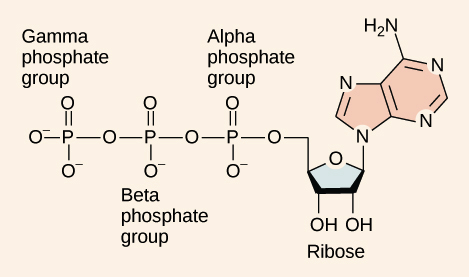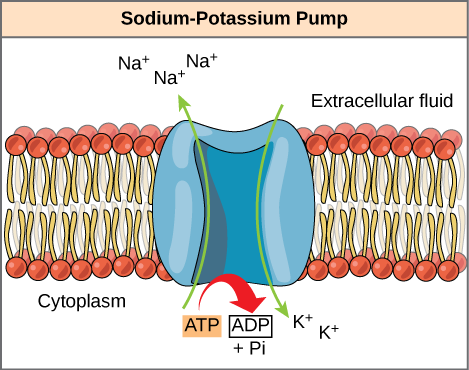Atp Is Expended in Which of the Following Cellular Processes
ATP is that accepted currency. This action requires energy which is provided by ATP.

Atp Cycle And Reaction Coupling Energy Article Khan Academy
A The structure of centrioles is similar to that of eukaryotic flagella and cilia.

. Most ATP however is generated during a separate process called oxidative phosphorylation which occurs during cellular respiration. ATP is used in the formation of macromolecules. Which of the following statements about the endoplasmic reticulum ER is CORRECT.
Group translocation active transport facilitated diffusion diffusion both active transport and group translocation Question 12 Some bacteria have an outer layer called a ________ which allows them to adhere to surfaces and contributes to their ability to cause disease. C The rough ER is the site of lipid synthesis. Glycolysis the Krebs cycle and electron transport.
Macromolecules are converted into cell structures via catabolism Sulfanilamide is an antimicrobial drug that mimics the shape of an important substrate for a particular bacterial enzyme thereby inhibiting the enzyme. Energy is released during cell metabolism when ATP is hydrolyzed. Myosin binds to actin at a binding site on the globular actin protein.
54 test answers. C Centrioles are found in a region of the cell called the centrosome. Cells need to have ATP because its the gasoline that powers all living things.
The motion of muscle shortening occurs as myosin heads bind to actin and pull the actin inwards. 15 ATP is expended in which of the following processes. Cellular respiration occurs in three stages.
The energy stored in 36 ATP molecules produced by aerobic respiration is 39 of the energy available in a six-carbon glucose and the other 61 of the glucose bond energy is lost. 1 _______ A The ER is a transport system within the cytoplasm. The process begins in the cytoplasm and is completed in a mitochondrion.
E both active transport and group translocation. We have just discussed two pathways in glucose catabolismglycolysis and the Krebs cyclethat generate ATP by substrate-level phosphorylation. In addition glycolysis makes ATP and converts NAD into NADH.
Myosin has another binding site for ATP at which enzymatic activity hydrolyzes. 23 Which of the following statements concerning centrioles is FALSE. Energy When ATP hydrolysis an exergonic reaction provides the energy for a simultaneous endergonic reaction this is an example of ___ reactions.
Through an intricate chain of chemical reactionsyour bodys currency exchangeglucose is converted into ATP. Cellular respiration is the process by which organic compounds preferably glucose are broken apart releasing energy that is used to produce ATP molecules. A facilitated diffusion B diffusion C group translocation D active transport E both active transport and group translocation.
B Centrioles are believed to play a role in cellular processes such as mitosis and cytokinesis. ATP is expended in which of the following processes. ATP is also added to nucleic acids during transcription.
Most ATP however is generated during a separate process called oxidative phosphorylation which occurs during cellular respiration. We have just discussed two pathways in glucose catabolismglycolysis and the Krebs cyclethat generate ATP by substrate-level phosphorylation. It is believed to be the neurotransmitter responsible for the sensation of taste.
D The smooth ER is a site of ATP synthesis. You need to convert your glucose into currency that will work in the cell. 15 ATP is expended in which of the following processes.
Biology questions and answers. The human central and peripheral nervous system in particular relies on ATP signaling. - ATP required - substance being transported is chemically altered - glucose enters the transport protein and is phosporylated becoming glucose-6-phosphate cant leave the cell.
ATP is a high energy nucleotide which acts as an instant source of energy within the cell. It splits the six-carbon sugar molecule into two three-carbon pyruvate molecules. Cellular respiration is a set of metabolic reactions and processes that take place in the cells of organisms to convert biochemical energy from nutrients into adenosine triphosphate ATP and then release waste products.
It comprises a series of membrane-associated protein complexes and associated mobile accessory electron carriers Figure 815. During glycolysis the cell breaks down glucose in the cytoplasm with or without oxygen being present. The electron transport system ETS is the last component involved in the process of cellular respiration.
Discuss why ATP is necessary for muscle movement. Normaals iStock Getty Images Plus The first step of cellular respiration is glycolysisGlycolysis occurs in the cytoplasm and involves. Eukaryotic cells depend on cellular respiration to survive.
Cellular respiration is the process in which cells break down glucose release the stored energy and use it to make ATP. ATP is the energy currency of a cell produced by the destruction of ADP expended in the process of photosynthesis produced during the phosphorylation of any organic compound Anything that prevents ATP formation will most likely result in cell death. B The smooth ER has ribosomes associated with it.
Myosin has another binding site for ATP at which enzymatic activity hydrolyzes ATP to ADP releasing an. The respiration of an 18-carbon. Electron transport is a series of chemical reactions that resembles a bucket.
Question 11 ATP is expended in which of the following processes. In addition to metabolic functions ATP is involved in signal transduction.

Atp Adenosine Triphosphate Biology 2e

Cellular Respiration Cellular Respiration Biochemistry Photosynthesis And Cellular Respiration

Cellular Respiration Cellular Respiration Biochemistry Photosynthesis And Cellular Respiration

0 Response to "Atp Is Expended in Which of the Following Cellular Processes"
Post a Comment